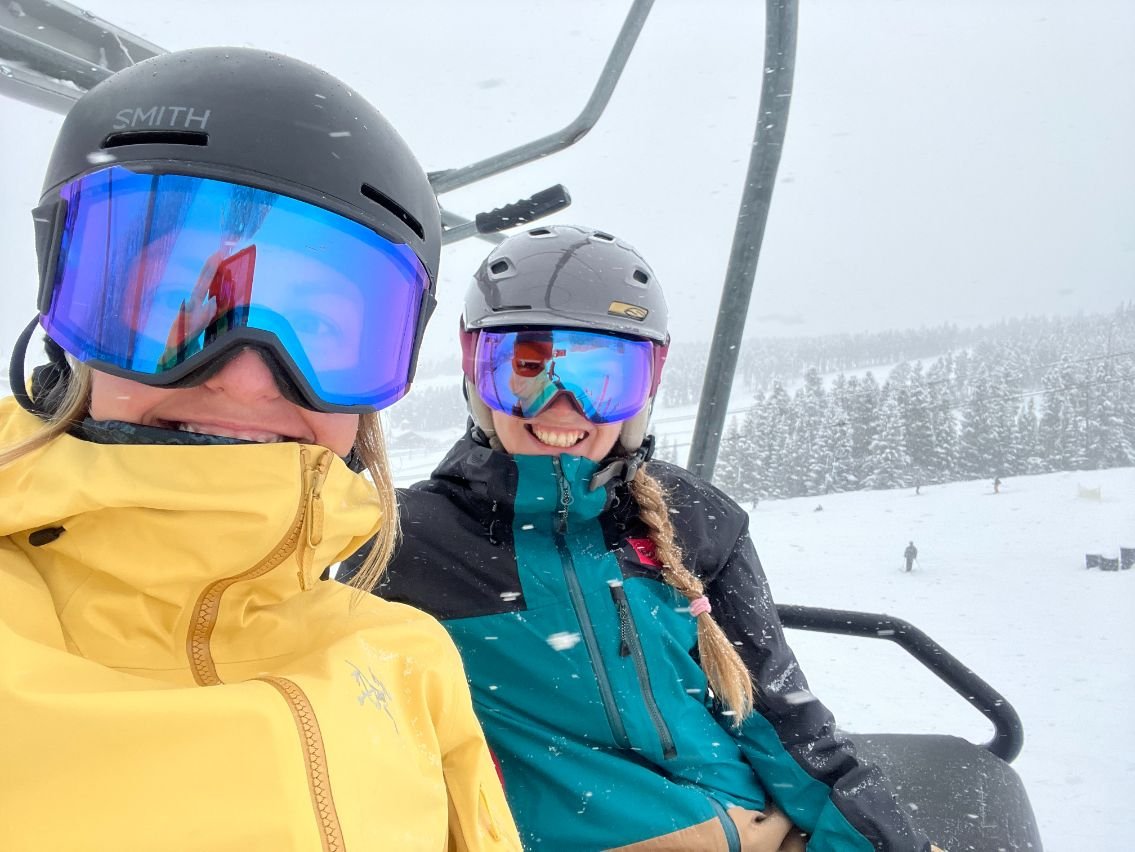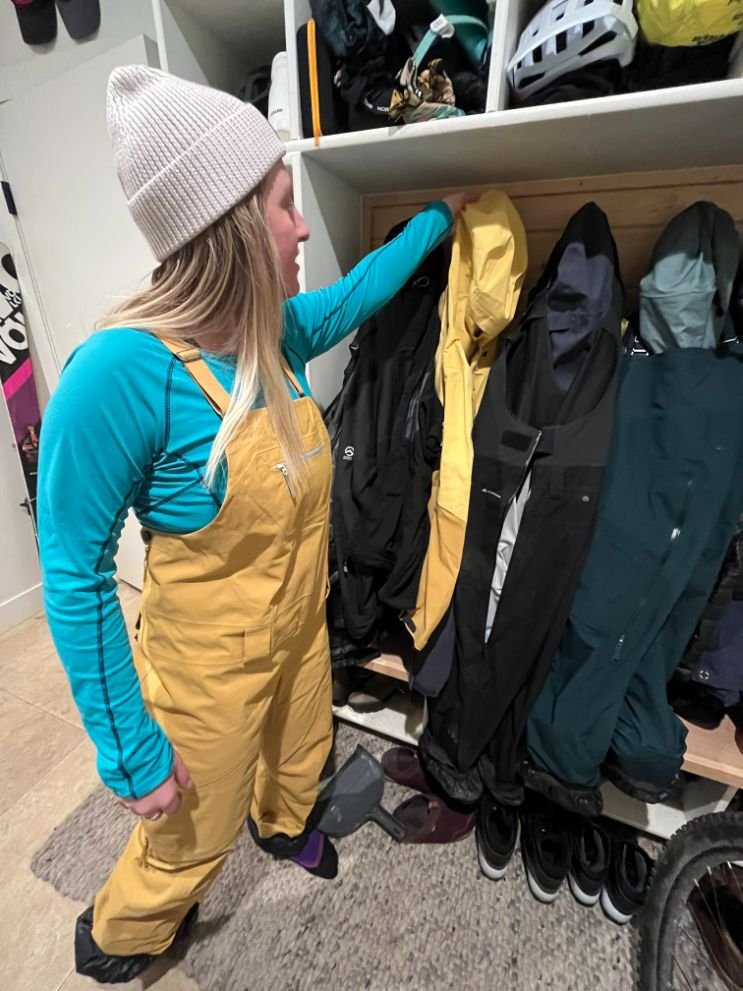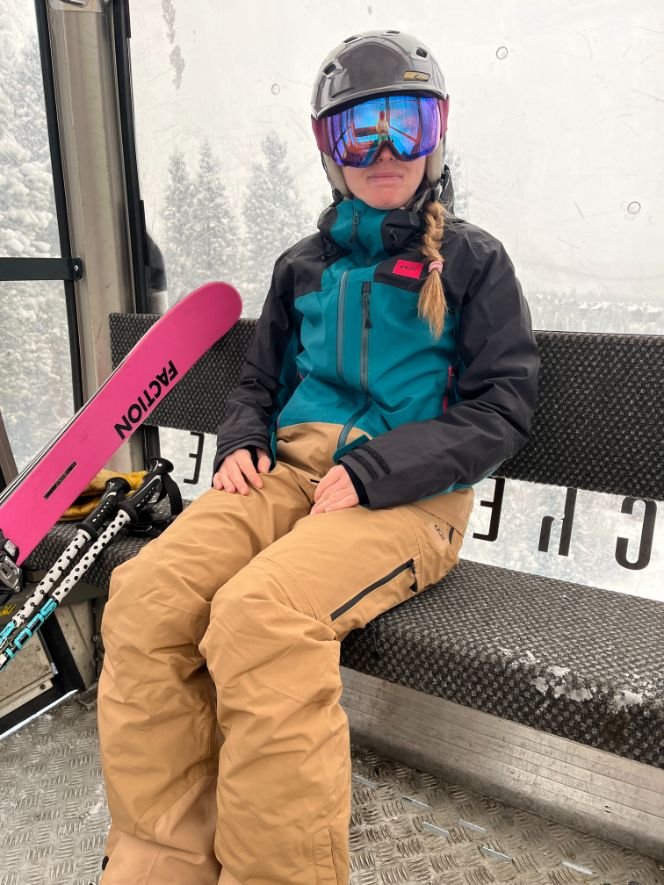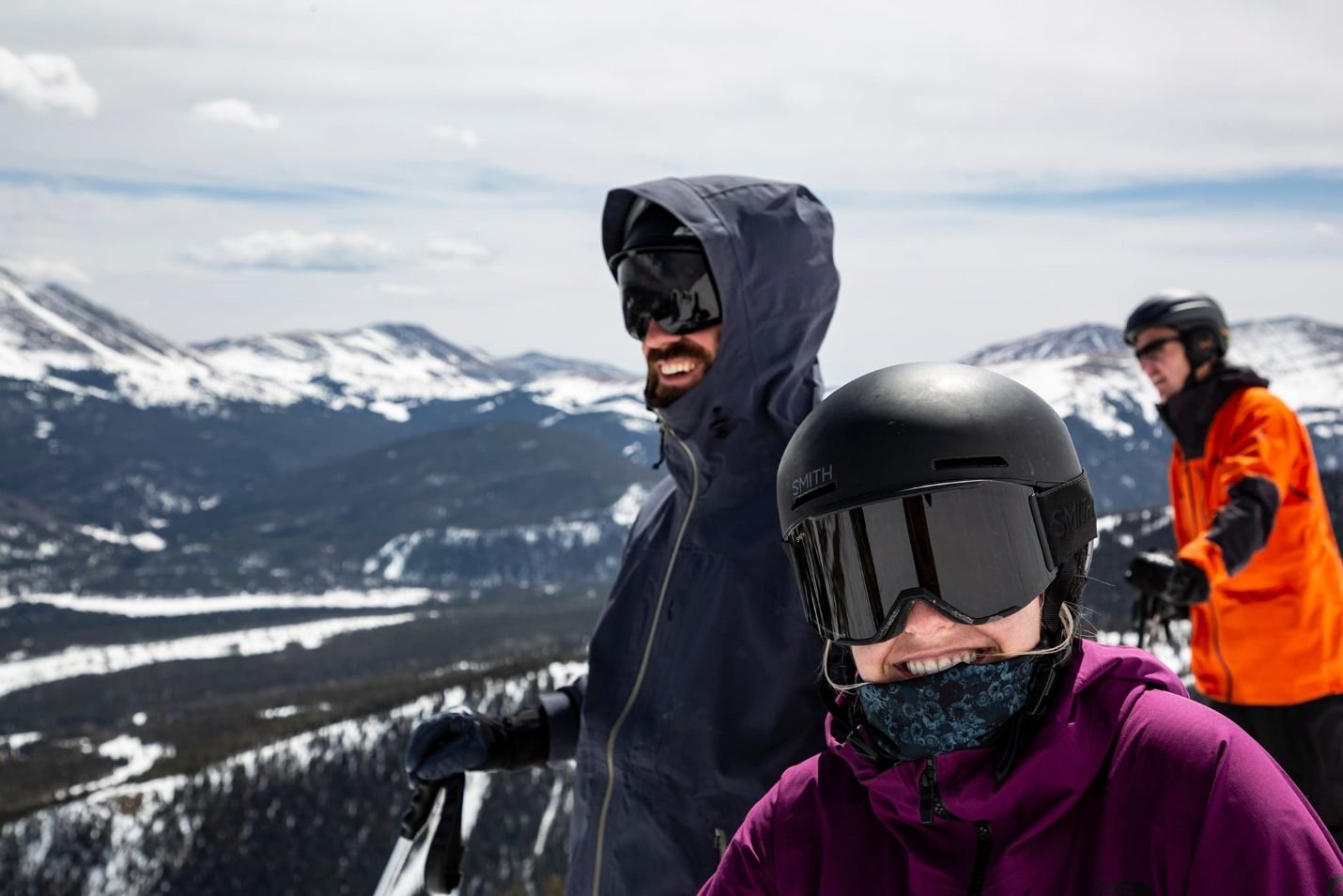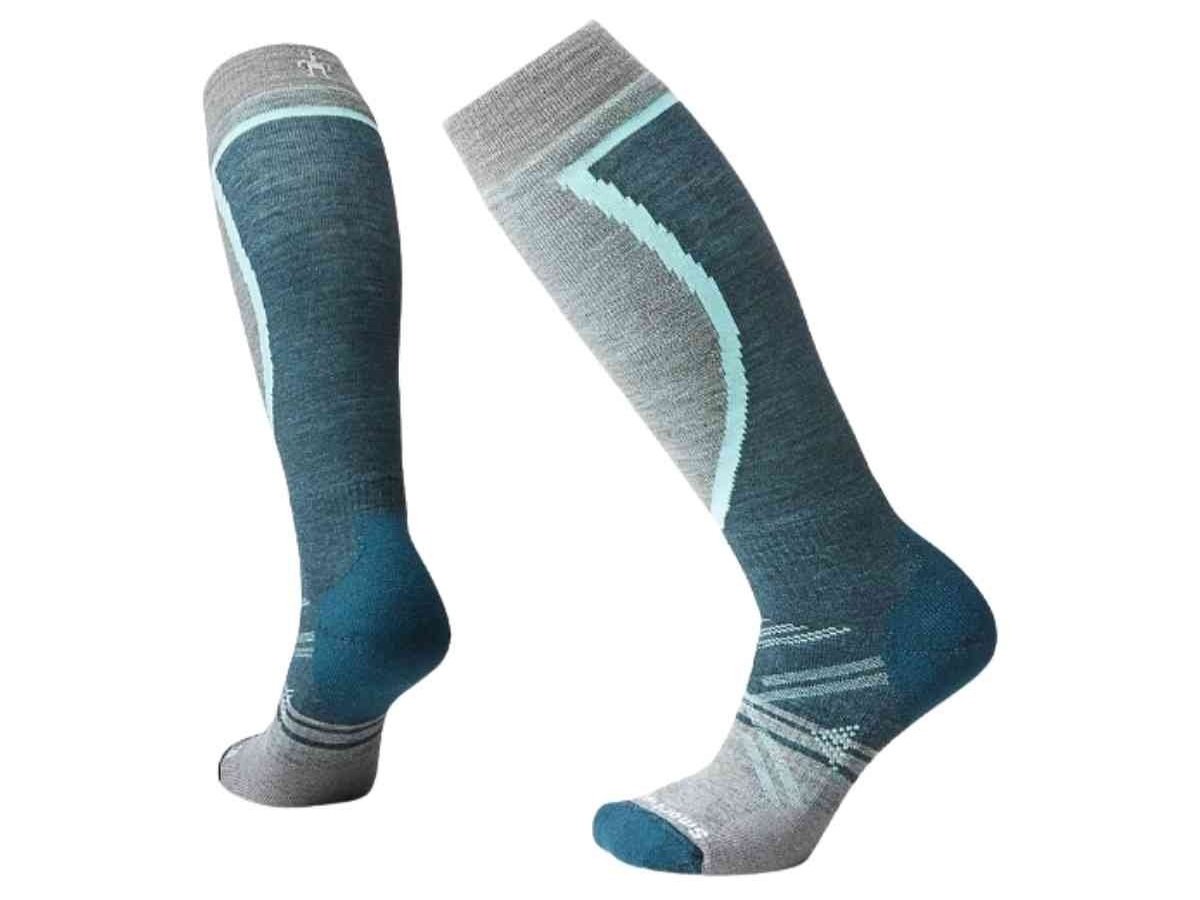What to Wear Skiing: A Beginner's Guide to Ski Clothing
Layering for Your First Time Resort Skiing
Updated November 4th, 2025
Skiing is meant to be fun, and being warm, dry, and comfortable while you’re out on the slopes will help with that. We’ve got some helpful tips for what to wear skiing to keep you toasty and smiling when you’re on the chair and making turns.
The author of this story is a lifelong skier with nearly a decade of professional experience in the outdoor industry, and she’s passionate about lowering barriers to entry for outdoor sports and helping others get into new sports like skiing.
She has spent many years writing gear reviews that help others know what to wear skiing and what equipment to use. Folks who did not have the opportunity to grow up on the slopes may not know what to wear or what gear to use, and that’s okay. Everyone has been a beginner at some point, and that’s why we wrote this beginner's guide to walk you through layering for your first time resort skiing.
See our Best Plus Size Winter Outdoor Clothing and Best Women’s Plus-size Snow Pants and Bibs guides for snow gear we like in sizes 1X-3X.
We create reader-supported, objective gear reviews independently selected by our editors. This story may contain affiliate links, which help fund our website. When you click on the links to purchase gear, we may get a commission, without costing you an extra cent. Thank you for supporting our work and mission of outdoor coverage for every body! Learn more.
What to wear skiing checklist
| SKI CLOTHING CATEGORY | PRODUCTS WE LIKE | MORE OPTIONS |
|---|---|---|
| Base Layer Top | Patagonia Capilene Midweight Crew Men's Women's |
Best Base Layers |
| Long Underwear | Ortovox Rock'N'Wool Short Pants Men's Women's |
Best Long Underwear for Men Best Long Underwear for Women |
| Ski Mid-Layer | The North Face Summit Series Futurefleece Full Zip Hoodie Men's Women's |
Best Fleece Jackets |
| Ski Jacket | Patagonia Powder Town Jacket Men's Women's |
Best Men's Ski Jackets Best Women's Ski Jackets |
| Ski Pants | The North Face Freedom Insulated Pants Men's Women's |
Best Men's Ski Pants Best Women's Ski Pants |
Ski jackets and outerwear are just part of the way to stay warm while skiing. What you wear under the jackets matters just as much. Here, the author is wearing a base layer and a bib-style ski pant.
How to layer for skiing
Staying comfortable while skiing means you need to be warm and dry. To do that, you will need to wear two kinds of layers together:
1. layers that protect you from the elements, like wind and snow
2. layers that will insulate to keep you warm, like mid layers and base layers.
How to stay warm while skiing
The key to staying warm in winter is to layer these two layers enough to stay toasty without overheating and becoming sweaty.
When skiing, the ride on the chairlift will be the coldest part.
You’ll warm up when skiing down the run.
Staying warm in these two different situations when you’re skiing is all about picking the right layers that can handle both cold and hot.
Ski resort temperatures in North America range depending on time of year and where you’re at, but you could be on the slopes in anything from temps below 0 degrees Fahrenheit to sunny days in the 40’s or higher, especially when spring skiing.
Base Layers
For your first layer right against the skin, you’ll want base layers that wick sweat and maintain warmth. Avoid cotton and instead pick synthetic fabrics like polyester or merino wool, which will wick sweat and dry quickly if they get wet. You'll want a base layer top and thermal underwear bottoms.
A base layer that wicks away sweat is essential to help you stay dry and warm. When your body or clothing are wet, you're more likely to feel evaporative cooling. By moving moisture away from your body, it's more likely to evaporate or at least make you not feel cold.
As far as fabrics for baselayers go, synthetic fabrics are more affordable but will hold on to odor more and won’t be as warm when wet. Merino wool will be more expensive but resists odor and stays warm when wet. Both work well as the first layer for skiing.
Find base layers that fit snugly but not too tight. There are many base layer options now available.
Mid layers
Next, you’ll want insulating layers, sometimes called the midlayer.
A fleece is a good option, or you might want a puffy jacket (down or synthetic) for particularly cold weather.
The number of insulating layers you put on will depend on whether or not your outer layer has insulation. If your ski jacket is insulated, you’ll need fewer midlayers to keep you warm. If your ski jacket is just a shell (meaning it has no insulation), you will probably want an extra layer underneath.
The same goes for your pants: a base layer underneath should suffice if your ski pants are insulated. Wear a thicker base layer or long underwear if your pants are only a shell.
Ski resorts are often in alpine settings where cold winds and blowing snow can make you feel colder. A good shell jacket and shell ski pant will protect you and keep you dry.
Shell Outer Layers
A waterproof shell layer (both jacket and pants) will do the trick to keep you dry. While snow coming from the sky can of course get you wet on the slopes, so can carving through the snow or falling (hey, we all do it!).
A shell jacket does not necessarily have insulation (but many do). Instead, the primary purpose of your outer layer is not to keep you warm but rather to keep you dry and protected from other elements, like wind.
Ski resorts are often in alpine settings, so experiencing cold wind is inevitable. While it depends on your specific location, it’s not uncommon to experience winds close to 40 miles per hour. You likely won’t see winds stronger than that, however, as that would cause the lifts to shut down in many cases.
Your outer layer should, most importantly, keep you dry. Make sure your ski jacket and pants are waterproof. If you run cold, it’s nice to have insulated ski wear. If you prefer to pick your layers based on the conditions, a waterproof shell for pants and a jacket will allow you to add layers depending on the temperature and weather.
Of all the layers, this is the one we recommend purchasing from a reputable ski brand. You can save money by renting, purchasing demos, or buying last year’s items.
Accessories
Finally, you want accessories like gloves or mittens and a neck gaiter to keep your extremities toasty and protected from the elements. These areas are more sensitive to cold because circulation often does not flow as well to these parts of the body compared to the core. You'll also want a snow goggle to protect your eyes from glare from the snow.
Check out more of our favorite ski accessories in our Guide to the Best Ski Accessories.
Skiing is supposed to be a fun experience—and having the right gear and making sure your body feels comfortable is the first step to focusing on having fun. Photo by Tom Callaghan
Clothes and accessories you need for skiing
This list covers ski essential clothing categories. We also give examples of models that we like that are reasonably priced and will last you many seasons. See our section below on ways to save money on ski gear for our recommendations for substitutions, rentals, and used gear options.
Base layer top
WHAT TO LOOK FOR:
A good base layer should keep you dry by wicking sweat while adding light insulation. Thus, it should not be made of cotton since cotton holds on to moisture, does not wick well, and will not keep you warm when it gets wet.
See more about what to look for in our guide to the Best Base Layers.
This base layer is the best, made of 100% synthetic material. While there are less expensive synthetic base layers, the quality and durability (not to mention relative eco-friendliness) of the Capilene Midweight (men's and women's) make it an excellent choice for skiing. It is also bluesign-approved, recycled polyester with Fair Trade Certified sewing.
WHAT WE DIDN’T LIKE:
While this synthetic base layer is better at resisting odor retention, it retains odor more than layers made of wool (which are often more expensive).
COMPARE PRICES OF THE PATAGONIA CAPILENE MIDWEIGHT CREW
MEN'S
WOMEN'S
Long underwear for skiing
WHAT TO LOOK FOR:
Like a baselayer top, look for synthetic or wool fabrics. While this does come down to personal preference, we prefer long underwear that stops at the calf for skiing so that there is no extra fabric to bunch up in your boots.
These merino wool pants offer warmth and wicking, and the length is just right for wearing ski or snowboard boots.
WHAT WE DIDN’T LIKE:
The wool material is more expensive than synthetic alternatives.
COMPARE PRICES OF THE ORTOVOX ROCK’N’WOOL SHORT PANTS
MEN'S
WOMEN'S
Ski midlayer
WHAT TO LOOK FOR:
A midlayer for skiing is for insulation. It does not need to be waterproof, but it should be made of technical materials (like synthetics or wool) that will dry quickly in case they get wet.
This fleece is very warm for how light it is and is wonderfully cozy. The fit is snug to avoid bulk, but there is plenty of room for a base layer underneath. Futurefleece is also partially made with recycled materials.
WHAT WE DIDN’T LIKE:
While this fleece is warm, it is not as insulating as a puffy layer. If you want more insulation or a puffy jacket, we recommend synthetic insulation over down as it can stay warm when wet.
For more midlayer options, check out our guide to the Best Midlayers.
COMPARE PRICES OF THE THE NORTH FACE SUMMIT SERIES FUTUREFLEECE FULL-ZIP HOODIE
MEN'S
WOMEN'S
Ski jackets
WHAT TO LOOK FOR:
When looking for a good ski jacket, consider something that is, first and foremost, weatherproof. It should block wind and shed moisture. If you prefer to layer underneath, pick a shell ski jacket with no insulation. If you want to think less about layering, pick a ski jacket with insulation that will help keep you warm.
For more on what to look for in a ski jacket, check out our guides to The Best Men’s Ski Jackets or The Best Women’s Ski Jackets.
OTHER THINGS TO CONSIDER:
Fit and features are important on a ski jacket. A ski jacket that fits on the looser side will leave room for more layers underneath while being comfortable and allowing for freedom of movement. Other features might include a powder skirt (to keep snow out), a helmet-compatible hood, pit zips (to vent body heat when necessary), and adjustable wrist cuffs (pretty standard).
The Patagonia Powder Town jacket is a waterproof ski jacket that comes in insulated and non-insulated versions. It has a helmet-compatible hood and a functional powder skirt that keeps snow out. It also has two zippered hand pockets, a chest pocket, and a pocket on the arm that holds a ski pass. This jacket is functional, comfortable, affordable, made with recycled materials, and Fair Trade Certified sewn. This jacket balances price, features, and durability, offering excellent value overall.
We also tested and wrote an in-depth review of the Patagonia Powder Town 3-in-1 Jacket as a similar option to consider.
WHAT WE DIDN’T LIKE:
We wish Patagonia offered a wider range of sizes in this jacket.
If you’re looking for another great beginner ski jacket to consider, check out our in-depth review of the Obermeyer Foundation Insulated Ski Jacket.
COMPARE PRICES OF THE PATAGONIA POWDER TOWN JACKET
MEN'S
WOMEN'S
Ski pants
WHAT TO LOOK FOR:
Much like a ski jacket, a good pair of ski pants should be waterproof and insulated if you want extra warmth. Other potential features include an adjustable waistband to help dial the fit, zippered vents, and internal gaiters that pull over your boots. To see more about what to look for in ski pants, see our guide to the Best Women's Ski Pants and Best Men’s Ski Pants guide.
The Freedom pants offer excellent value. While they are not the cheapest ski pants on the market, they are an excellent pair that will last most skiers multiple seasons of use. The Freedom pants are versatile resort pants, ideal for most days on the mountain.
We tested them for groomer laps on warm, sunny days and took them out for mid-winter storm skiing. After a couple of seasons of testing, we’ve been impressed with how well these pants perform in various conditions, especially for the price.
They’ve got Velcro adjustments on the waistband, internal gaiters, and zippered vents in the thighs. We appreciate that these pants are also offered in plus sizing. We wrote an article dedicated to why we like The North Face Freedom Ski Pants so much.
WHAT WE DIDN’T LIKE:
While these pants have functional pockets, we wish they were a bit larger and would love for the thigh pocket to be zippered for extra security.
COMPARE PRICES OF THE THE NORTH FACE FREEDOM PANTS
MEN'S
WOMEN'S
For more plus-size options, read our guide to Best Women’s Plus-Size Snow Pants and Bibs.
Ski socks
WHAT TO LOOK FOR:
Getting the right pair of ski socks is vital for a good fit in your ski boots. Look for socks that fit well and aren’t loose or bunched up. Do not wear short socks as they will fall or bunch in your boots. Instead, use socks explicitly made for skiing that go up over your calf. Ski socks come in synthetic and wool options. We prefer a wool-blended sock for the ideal balance of fit, wicking, and durability. For more on what to look for in ski socks, see our guide to Best Wool and Synthetic Ski Socks.
The midweight thickness strikes the right balance between a precise fit and enough padding and warmth. Smartwool makes ski socks in various thicknesses, but we think the midweight offers the best overall performance for most skiers.
WHAT WE DIDN’T LIKE:
If you prefer very thin socks, these will be too thick.
COMPARE PRICES OF THE SMARTWOOL SKI FULL CUSHION SOCKS
MEN'S
WOMEN'S
Ski face mask
WHAT TO LOOK FOR:
Like base layers, a face mask for skiing should be made of synthetic materials or merino wool. You’ll want something soft that you can wear against your face and neck.
Our choice: Buff Merino Midweight Neck Warmer
WHAT WE LIKED:
This neckwarmer is made with a blended merino fabric that keeps you warm, even when wet, and resists odor. It is snug, not bulky, and can be worn around your neck or over your neck and ears if needed.
WHAT WE DIDN’T LIKE:
This mask is not as durable as other options.
COMPARE PRICES OF THE BUFF MERINO MIDWEIGHT NECK WARMER
Ski gloves
WHAT TO LOOK FOR:
As with most ski gear, you want your ski glove to keep your hands warm and dry. Gloves offer more dexterity, while mittens will keep you warmer if you tend to run cold. Whether you choose gloves or mittens, it comes down to personal preference. For more on what to look for in a ski glove, see our guide The Best Ski Gloves.
Our choice: Hestra Fall Line Gloves
WHAT WE LIKED:
Hestra is known for excellent quality and durability. These leather gloves will last many ski seasons while keeping you warm and dry. One main advantage to leather gloves is that they can be re-treated to maintain their weather resistance.
WHAT WE DIDN’T LIKE:
These gloves are excellent, but they aren’t cheap.
COMPARE PRICES OF THE HESTRA FALL LINE GLOVES
Ski goggles
WHAT TO LOOK FOR:
The lens is the most important part of a good pair of ski goggles. You want to be able to see through changing weather conditions, whether it’s bluebird and sunny or stormy and snowing. It’s essential that the lenses offer clarity and that they don’t fog up when you’re skiing. Many goggles now have the option to swap lenses depending on lighting and weather. This is a very nice feature if you can afford to spend a little more on your goggles. Finally, look for a pair that fits your face well. They’ll be more comfortable and functional that way. For more on what to look for in a Ski Goggle, see our guide to The Best Ski and Snowboard Goggles.
These goggles have a fit that works well with many faces and head shapes and sizes. We also like the ChromaPop lenses that help add definition to snowy landscapes. Magnetic lens change makes it easy to swap out the lens, even in the lift line or while riding the chair.
WHAT WE DIDN’T LIKE:
Depending on the exact lens choice and color, they can be a bit expensive.
Read more in our in-depth review of the Smith I/O Mag Goggles.
COMPARE PRICES OF THE SMITH I/O MAG GOGGLES
MEN'S
WOMEN'S
Ski helmet
WHAT TO LOOK FOR:
Protection is the most critical factor in a ski helmet. A rotational protection system, like Mips or something similar, is the most notable safety feature in a ski helmet. This system means that your head is protected from direct and rotational impacts in the event of a crash. Other things to look for include venting, adjustability, and tech compatibility. For more on what to look for, see our guide to The Best Ski and Snowboard Helmets.
Our choice: Smith Vantage 2 mips helmet
WHAT WE LIKED:
The Vantage is a top-of-the-line helmet that offers an ideal combo of safety, features, and style. While it is more expensive than others, a good helmet is worth the price. The Vantage features Mips technology, has a BOA adjustment in the back that dials fit, multiple vents for airflow, and is compatible with music systems that zip into the padded ears of the helmet.
WHAT WE DIDN’T LIKE:
This helmet is one of the more expensive options on the market.
For a quality helmet at a more affordable price, we recommend checking out our in-depth review of the Smith Method MIPS Ski Helmet.
COMPARE PRICES OF THE SMITH VANTAGE 2 MIPS HELMET
What you Should not wear while skiing
Cotton
For all of your ski layers, avoid cotton since it holds onto moisture. Instead, opt for synthetic and wool fabrics.
Non-Waterproof Outer Layers
For outer layers, ensure they’re waterproof so you stay dry on the slopes.
The most important features of ski clothing
Stay Warm and Dry
Ski clothing should, most importantly, keep you warm and dry. So look for features that help do this.
Wind and Waterproofness
Your outer layers should be wind and waterproof, and midlayers should offer insulation without being too bulky.
Keep Snow Out
Other features like a powder skirt, adjustable cuffs, and a storm hood will also help to keep you warm and dry by keeping snow out.
Ways to save money on ski gear: Use what you have and rent when possible
While ski-specific gear will always be the best tool for the job, whether it’s a jacket or a pair of socks, there are times when the gear you have will work just fine, especially if you’re trying out the sport for the first time.
It is by all means not necessary to buy all new ski-specific gear and apparel for your first ski trip.
For base layers, if you have technical shirts that you wear hiking, running, or to the gym, use those as long as they’re not made of cotton.
If you have a waterproof rain jacket, wear that with a warm layer underneath instead of splurging on a ski-specific coat.
Most ski towns and resort areas have great rental options; take advantage of this. You do not need your own hard goods.
We recommend renting items like:
Renting this gear will save you a good deal of money.
Both REI and Evo offer gear rental programs in the major cities near most major ski resorts. So if you're flying into a ski resort, you can swing by and pick up rental gear.
Evo's rental is available in Seattle, Denver, Portland, Whistler, Salt Lake City, and Snoqualmie Pass (Tahoe coming soon).
When you do decide to purchase your own ski gear, we recommend purchasing from a reputable ski brand. While they may seem more expensive, they will last you longer and not need replacing as often as you grow as a skier. You can save money on ski gear by purchasing used or demo gear or picking up last year’s models.
The author wearing the Patagonia Powder Town ski jacket. The Powder Town is available as a shell only or a 3-in-1 jacket, which includes a midlayer and shell and can be converted into an insulating jacket. A 3-in-1 style can be a good way to stretch one ski jacket for cold weather skiing and warmer spring skiing.
What ski gear should i buy first?
When it’s worth it to spend money on new gear
There are certain pieces of ski gear that are worth spending money on instead of renting, or that should not be substituted.
The helmet you use when skiing should be a ski-specific helmet (whether it’s a rental or your own). Do not use a bike helmet or climbing helmet when skiing—they are not designed for the types of impacts you may encounter on skis, and they also do not offer warmth as a ski helmet will.
Sometimes the small things make a difference. It’s worth buying a pair of your own ski socks. You’ll not only be more comfortable, but your feet will stay warmer, and you’ll get more performance out of your boots with a good pair of ski socks.
Hiking socks do not work as well as ski socks; they’re usually too short, too thick, or don’t fit quite right to be shoved into a ski boot. Ski socks should be long enough to reach the top of your calf, they should fit snugly to prevent bunching in the boot, and they shouldn't be overly thick. Even if you only plan to ski once, we think it’s worth having a good pair of ski socks.
If you know you plan to ski more than just a few times and want your own gear, it’s not a bad idea to slowly acquire what you need. When it comes to hard goods, boots are the most important piece of ski gear and the item most worth spending money and time on to ensure you get a good fit and a boot that is right for you. Also, check out our related guide to the Best Ski Boot Bags. Even if you aren’t traveling a long ways to ski, boot bags are so helpful for keeping all your winter/ski-specific gear in place! (Stash your boots and socks, ski pants, an extra layer, snacks, helmet, a rental or resort receipt, etc. so you don’t forget anything you need for the day!)
Other gear, like your beginner-friendly skis and poles, are important too, but not as much as boots. As the industry saying goes, you date your skis but you marry your boots.
If you do find yourself skiing often, you’ll benefit from ski-specific apparel. Ski jackets and snow pants have ski-specific features and fit that make them more comfortable and functional than other outdoor apparel, like a rain jacket or hiking pants. If you ski often, consider treating yourself to some quality apparel that will be comfortable, functional, and durable for many seasons.
Stasia Stockwell is a lifelong skier passionate about reducing barriers to entry in the outdoors and fostering joy outside for more people. Photo by Tom Callaghan
About the author / Why you should trust us
A true mountain dweller, Stasia feels far more at home on a high alpine ridge than on a busy city street. She writes primarily in the outdoors, adventure travel, and environmental realm. She’s worked as a backpacking guide in Southeast Alaska, has held WFR, AIARE 1, and Avalanche Rescue certifications, and is working to become an avalanche education instructor.
Her bylines can be found in BACKPACKER Magazine, 5280 Magazine, and REI Co-op Journal, among others. She is also the managing editor of the new print zine, Trails Magazine. Stasia is a lifelong skier, backpacker, mountain biker, and trail runner with a passion for lowering barriers to entry for outdoor sports. When she’s not writing or cooking, you’ll find her in the mountains, probably above treeline, and probably testing gear.
Stasia has spent every winter season skiing since she could walk. She grew up skiing in the mountains of northern Utah and now calls Breckenridge, Colorado home, where she gets out on skis almost every day as long as there is snow to be found somewhere.
She has taken her skis from Alaska to Japan but primarily spends her time making turns in the intermountain west. She’s been working in the outdoor industry, from guiding and testing outdoor gear and apparel to writing and editing for nearly a decade.
You can see all of Stasia's Treeline Review stories on her author page and her other work on her website.

